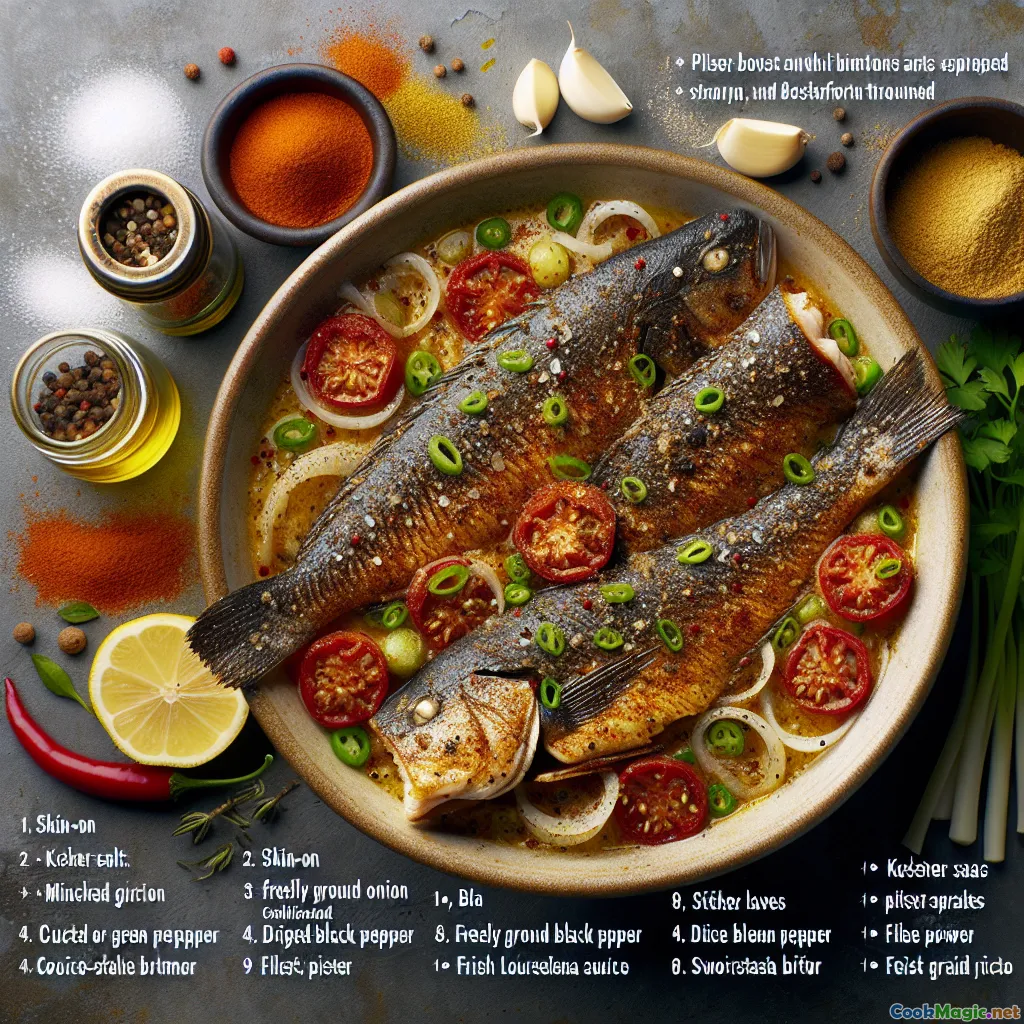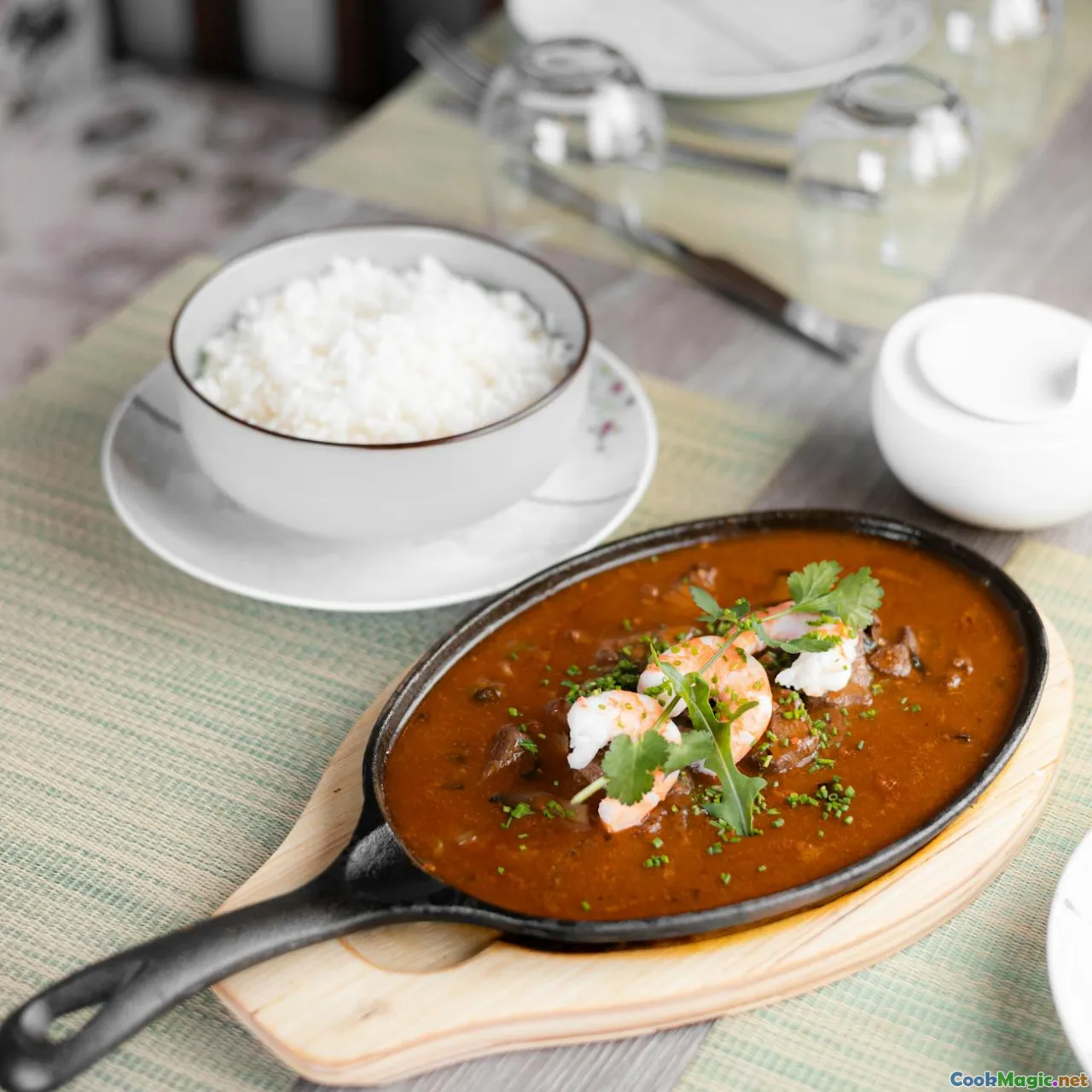
Court-bouillon de redfish de la Nouvelle-Orléans avec sauce tomate et roux
(NOLA Redfish Courtbouillon with Tomato-Roux Gravy)
(0 Avis)0
380
octobre 26, 2025
Signaler un problème
Ingrédients
-
680 grams Filets de redfish avec peau, sans arêtes fines
(Can substitute drum, snapper, or catfish)
-
2 tsp Sel kasher
(Divided; adjust to taste)
-
1 tsp Poivre noir, fraîchement moulu
(Divided; adjust to taste)
-
0.5 tsp Poivre de Cayenne
(Adjust heat level to preference)
-
2 tsp Paprika doux
(Adds color and gentle warmth)
-
4 tbsp Huile neutre (arachide ou végétale)
(For making a blond-to-medium roux)
-
4 tbsp Farine tout usage
(Equal volume to oil for roux)
-
1 large Oignon jaune, coupé en dés
(Part of the trinity)
-
1 medium poivron vert, coupé en dés
(Part of the trinity)
-
2 stalks Céleri en branches, coupé en dés
(Part of the trinity)
-
4 cloves Gousses d'ail, hachées
(Frais pour une meilleure saveur)
-
2 tbsp Concentré de tomate
(Caramelizes for depth)
-
800 grams Tomates écrasés
(28-oz can; fire-roasted preferred)
-
3 cups Bouillon de fruits de mer ou de poisson
(Recommandé faible en sodium)
-
2 leaves Feuilles de laurier
(Retirer avant de servir)
-
4 sprigs Brins de thym frais
(ou 1 cuillère à café de thym séché)
-
2 tsp Sauce Worcestershire
(Adds savory depth)
-
1 tsp Sauce piquante à la Louisiane
(Optional kick; add to taste)
-
2 tbsp Jus de Citron Frais
(Brightens the sauce)
-
1 tbsp Beurre non salé
(Finish for silkiness)
-
2 stalks Oignons verts finement tranchés
(Green parts for garnish)
-
0.25 cup Persil plat, haché
(Garniture fraîche)
-
4 cups riz blanc à grains longs cuit
(Warm; for serving)
-
0.5 tsp Poudre de filé
(Optional, for subtle earthiness (add off-heat))
(Can substitute drum, snapper, or catfish)
(Divided; adjust to taste)
(Divided; adjust to taste)
(Adjust heat level to preference)
(Adds color and gentle warmth)
(For making a blond-to-medium roux)
(Equal volume to oil for roux)
(Part of the trinity)
(Part of the trinity)
(Part of the trinity)
(Frais pour une meilleure saveur)
(Caramelizes for depth)
(28-oz can; fire-roasted preferred)
(Recommandé faible en sodium)
(Retirer avant de servir)
(ou 1 cuillère à café de thym séché)
(Adds savory depth)
(Optional kick; add to taste)
(Brightens the sauce)
(Finish for silkiness)
(Green parts for garnish)
(Garniture fraîche)
(Warm; for serving)
(Optional, for subtle earthiness (add off-heat))
Nutrition
- Portions: 4
- Taille de portion: 1 bol (350g)
- Calories: 480 kcal
- Carbohydrates: 0 g
- Protein: 34 g
- Fat: 16 g
- Fiber: 5 g
- Sugar: 10 g
- Sodium: 980 mg
- Cholesterol: 85 mg
- Calcium: 120 mg
- Iron: 2.8 mg
Instructions
-
1 - Season the fish:
Pat redfish fillets dry. Season both sides with 1 tsp kosher salt, 1/2 tsp black pepper, and a pinch of cayenne. Let rest at room temperature while you build the gravy.
-
2 - Make a blond-to-medium roux:
In a heavy 5–6 qt cast-iron or Dutch oven over medium heat, warm the oil. Sprinkle in flour and whisk continuously until the roux turns the color of peanut butter. Do not burn; lower heat if it smokes.
-
3 - Sweat the trinity:
Add onion, bell pepper, and celery. Stir to coat in roux. Cook, stirring, until softened and glossy, 5–7 minutes. If roux tightens, splash with a few tablespoons of stock.
-
4 - Bloom aromatics and tomato paste:
Add garlic, paprika, remaining cayenne (if using), and tomato paste. Cook, stirring, until fragrant and the paste darkens slightly, about 2–3 minutes.
-
5 - Build the tomato gravy:
Stir in crushed tomatoes, seafood stock, bay leaves, thyme, Worcestershire, and remaining 1 tsp salt and 1/2 tsp black pepper. Scrape up any fond from the bottom of the pot.
-
6 - Simmer and balance:
Bring to a gentle simmer. Partially cover and cook 12–15 minutes, stirring occasionally, until flavors meld and the sauce thickly coats a spoon. Adjust seasoning; add hot sauce if desired.
-
7 - Nestle and poach the fish:
Reduce heat to low. Submerge seasoned redfish fillets in a single layer, skin side up. Cover and gently simmer 8–10 minutes, or until fish just flakes and turns opaque.
-
8 - Finish with lemon and butter:
Remove pot from heat. Stir in lemon juice and butter until melted. Discard bay leaves and thyme sprigs. If using filé powder, sprinkle now and gently stir.
-
9 - Herb and garnish:
Fold in most of the parsley and scallions, reserving a little for garnish. Taste and fine-tune salt, pepper, and acidity.
-
10 - Serve over rice:
Spoon hot rice into bowls. Ladle courtbouillon around and over rice, laying a portion of fish on top. Garnish with remaining herbs and a dash of hot sauce if you like.
-
11 - Rest and enjoy:
Let bowls sit 2–3 minutes to settle and thicken slightly before serving. Serve with lemon wedges for extra brightness.
Pat redfish fillets dry. Season both sides with 1 tsp kosher salt, 1/2 tsp black pepper, and a pinch of cayenne. Let rest at room temperature while you build the gravy.
In a heavy 5–6 qt cast-iron or Dutch oven over medium heat, warm the oil. Sprinkle in flour and whisk continuously until the roux turns the color of peanut butter. Do not burn; lower heat if it smokes.
Add onion, bell pepper, and celery. Stir to coat in roux. Cook, stirring, until softened and glossy, 5–7 minutes. If roux tightens, splash with a few tablespoons of stock.
Add garlic, paprika, remaining cayenne (if using), and tomato paste. Cook, stirring, until fragrant and the paste darkens slightly, about 2–3 minutes.
Stir in crushed tomatoes, seafood stock, bay leaves, thyme, Worcestershire, and remaining 1 tsp salt and 1/2 tsp black pepper. Scrape up any fond from the bottom of the pot.
Bring to a gentle simmer. Partially cover and cook 12–15 minutes, stirring occasionally, until flavors meld and the sauce thickly coats a spoon. Adjust seasoning; add hot sauce if desired.
Reduce heat to low. Submerge seasoned redfish fillets in a single layer, skin side up. Cover and gently simmer 8–10 minutes, or until fish just flakes and turns opaque.
Remove pot from heat. Stir in lemon juice and butter until melted. Discard bay leaves and thyme sprigs. If using filé powder, sprinkle now and gently stir.
Fold in most of the parsley and scallions, reserving a little for garnish. Taste and fine-tune salt, pepper, and acidity.
Spoon hot rice into bowls. Ladle courtbouillon around and over rice, laying a portion of fish on top. Garnish with remaining herbs and a dash of hot sauce if you like.
Let bowls sit 2–3 minutes to settle and thicken slightly before serving. Serve with lemon wedges for extra brightness.
En savoir plus sur: Court-bouillon de redfish de la Nouvelle-Orléans avec sauce tomate et roux
What makes this courtbouillon special
Courtbouillon in Louisiana is not the delicate poaching liquid you might expect from classic French cuisine. In New Orleans and across Acadiana, it’s a tomato-forward, gently thickened fish stew with deep roots in Creole and Cajun kitchens. This Savory NOLA Redfish Courtbouillon leans into a blond-to-medium roux for body, the holy trinity (onion, bell pepper, celery) for aroma, and a balanced tomato gravy sharpened by lemon. Redfish—once the pride of Gulf waters—poaches directly in the sauce, absorbing aromatics while remaining tender and flaky.
Taste and texture
- Body: A silky roux supports, not smothers, the tomatoes. Aim for peanut-butter hue—enough nuttiness to enrich without turning bitter.
- Flavor: Layers of sweetness from caramelized tomato paste, savory depth from Worcestershire, briny backbone from seafood stock, and a bright snap of lemon at the end.
- Heat: Cayenne and Louisiana-style hot sauce provide adjustable warmth without overwhelming the fish.
- Finish: A small pat of butter gives the gravy gloss; fresh parsley and scallions keep it lively.
Tips for success
- Control the roux: Keep it moving and keep your heat moderate. If it starts to smoke, pull the pot off the burner for a moment and stir.
- Don’t overcook the fish: Redfish thickens quickly. Simmer gently and remove from heat as soon as it flakes. Overcooking will make it stringy.
- Season in stages: Divide your salt and pepper to season the fish and the gravy separately, then adjust at the end. Tomatoes and stock can vary in salinity.
- Brightness matters: Lemon juice at the finish lifts the entire stew. Taste before adding; you want a rounded, not sour, finish.
- Filé finesse: If using filé powder, stir it in off-heat to avoid stringiness. It adds a whisper of earthiness and a satiny body.
- The right pot: A heavy Dutch oven holds steady heat and keeps the roux from scorching. Cast-iron is classic.
Ingredient notes and smart swaps
- Redfish: Drum, snapper, sheepshead, or catfish perform well. Choose skin-on fillets if possible—they hold together better while poaching.
- Stock: Seafood stock elevates the dish; in a pinch, a 50/50 mix of clam juice and water works. Low-sodium lets you control seasoning.
- Trinity: Green bell pepper is traditional, but a mix of green and red peppers creates a nice color play without altering heritage.
- Paprika: Sweet paprika delivers color; a touch of smoked paprika can bring subtle depth, but use it sparingly to keep the Gulf character.
- Rice: Long-grain white rice is a classic base. Steamed jasmine works; for a nutty twist, use medium-grain or Carolina Gold.
Make-ahead and storage
- The sauce can be made a day in advance through Step 6. Reheat gently, then add fish to poach just before serving.
- Leftovers keep 2 days refrigerated. Rewarm on low, adding a splash of stock or water to loosen. Avoid multiple reheats with fish to prevent dryness.
Cultural context and history
Louisiana’s courtbouillon is a beautiful example of culinary creolization. French technique meets West African spice sense, Spanish tomato culture, and Indigenous knowledge of Gulf waters. In early New Orleans, cooks used readily available fish—especially redfish and drum—paired with preserved tomatoes and garden herbs. Roux, introduced by European cooks and adapted across the region, became a staple thickener, evolving from pale to dark depending on the dish. While gumbo turns the roux dark and nutty, courtbouillon prefers a lighter shade so tomatoes remain bright and the fish shines.
In family kitchens and neighborhood restaurants, courtbouillon often appears for Friday suppers or Lenten meals. It’s generous, economical, and welcoming—easy to stretch with extra rice or a little more stock. The signature balance of warmth, tang, and savor speaks to New Orleans’ talent for harmony among disparate influences, much like the city’s music.
Serving ideas
- Spoon over rice with lemon wedges and extra hot sauce on the table.
- Add a side of simple vinegar-dressed greens or crisp coleslaw for contrast.
- A hunk of French bread is perfect for chasing the last spoonfuls of gravy.
Why this version works
This recipe honors tradition while making smart, home-cook-friendly moves: a manageable roux, canned crushed tomatoes for consistency, and a gentle, predictable poach. The Worcestershire sneaks in umami without masking the fish; lemon and fresh herbs keep the finish bright. Optional filé offers a nod to gumbo’s texture without turning the dish murky. Most importantly, the method safeguards the fish, ensuring it remains the star.
Cook this NOLA Redfish Courtbouillon when you want something comforting yet vivid—the culinary equivalent of brass bands on a warm evening: rootsy, soulful, and impossible not to love.






















